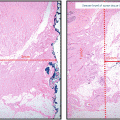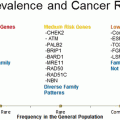Because of clinical trials, data revealing advantages of endocrine therapy to reduce local recurrence following breast-conserving surgery for DCIS, it is now commonplace to perform immunohistochemistry studies evaluating for estrogen receptor (ER) and/or progesterone expression in these cases [12, 13]. African American women with invasive breast cancer have higher frequencies of ER-negative and triple-negative tumors [14, 15] and so it is reasonable to question whether or not molecular patterns might vary by racial-ethnic identity among women with DCIS as well. The very high majority (70–90 %) of DCIS cases overall are positive for hormone receptor expression and interestingly, two studies have actually shown African American DCIS cases to have relatively higher rates of ER positivity compared to DCIS patients with other backgrounds [16, 17] .
Treatment and Clinical Trials Data
Prior to the advent of large-scale mammography screening programs, DCIS was only identified when it happened to be detected within a palpable breast mass. In this era, both invasive and noninvasive breast cancers were treated by mastectomy. In the late 1980s through early 1990s, the National Surgical Adjuvant Breast Project (NSABP) implemented two prospective, randomized clinical trials that were specifically designed to evaluate breast-conserving surgery for DCIS. The NSABP B-17 trial randomized DCIS patients to lumpectomy with versus without adjuvant breast radiation, and the follow-up NSABP B-24 trial randomized women to lumpectomy and breast radiation followed by 5 years of adjuvant tamoxifen versus no adjuvant endocrine therapy . The proportion of African Americans participating in these trials ranged from only 6.0–7.6 %, and while no details regarding race/ethnicity-specific recurrence rates are available, race-ethnic identity was not reported as a risk factor for treatment failure in either of these two clinical trials [18] .
Two population-based studies have reported on surgical treatment patterns for DCIS, stratified by race/ethnicity. Innos and Horn-Ross [19] analyzed data from the California Cancer Registry, and Wu et al. [20] reported findings from the SEER and Louisiana State tumor registry. These studies showed similar treatment patterns in terms of breast-conserving surgery versus mastectomy for African American, White American [19, 20], and Hispanic American [19] DCIS patients, but the California study revealed higher rates of mastectomy for Asian–Pacific Islander patients [19].
Outcome Disparities
In general, survival rates from DCIS are excellent, regardless of treatment strategy, as these preinvasive cancer lesions are incapable of distant metastatic spread. Patients experiencing a local recurrence following breast-conserving surgery (with or without adjuvant radiation therapy) have an equal risk of having an invasive or a DCIS recurrence [21]. Studies of possible race/ethnicity-associated DCIS outcome disparities would therefore reasonably focus heavily on risk of local recurrence as well as distant recurrence .
Several studies—some population-based, others from single institutions—have revealed varying degrees and patterns of treatment failure for DCIS related to racial/ethnic identity. The largest study [22] was a pooled analysis of studies conducted internationally on DCIS outcomes, including five randomized controlled trials; 64 observational studies; ten SEER-based studies; and 65 reports from cancer registries as well as academic centers in the USA. This robust composite study demonstrated worse local and distant survival outcomes for African American patients. The included SEER-based pooled analyses revealed a 35 % higher overall mortality for African American compared to White Americans (RR = 1.35; 95 % confidence interval 1.12–1.62). Risks of invasive recurrences and advanced recurrences were increased for African Americans as well as Hispanic/Latinas.
A SEER analysis by Li et al. [23] evaluated incidence rates of invasive cancer among patients with a prior history of DCIS; these rates were 5.4/1000 person years and 4.5/1000 person years for ipsilateral and contralateral invasive disease, respectively. African American women and Hispanics had more than twice the risk of being diagnosed with stage III/IV breast cancer compared to White Americans. Similarly, the California Cancer Registry reported a nearly two-fold higher relative risk of invasive ipsilateral breast cancer among African American women previously treated for DCIS, and this disparity persisted for the entire cohort as well as for the group after exclusion of the mastectomy cases [24]. African American DCIS patients had a 1.6 relative risk (95 % confidence interval 1.1–2.1) of local recurrence after breast-conserving surgery among nearly 3000 women treated in the Cancer Research Network (CRN), a consortium of 14 integrated health-care delivery systems [25]. In contrast to the studies showing African American background to be a risk factor for invasive recurrence and/or new disease, the increased local recurrence risk seen in the CRN was limited to noninvasive recurrence.
The MD Anderson Cancer Center (MDACC) [16, 26] and the Henry Ford Health System [27] both reported individual institution-based experiences with DCIS outcomes related to racial/ethnic identity. The two studies from MDACC had seemingly contrasting results. In their retrospective analysis of nearly 2000 DCIS patients (74 % White American; 11 % African American; 9 % Hispanic; and 5 % Asian/Pacific Islander) with 4.8 years median follow-up, there were no race/ethnicity-related outcome differences , but the Hispanic patients tended to be younger than the African American and White American patients [16]. However, a separate analysis looked at 25 patients experiencing distant metastatic disease among 2123 cases of pure DCIS (frequency of distant metastasis 0.14 %). Interestingly, African Americans accounted for 24 % of the patients with metastatic disease, despite accounting for only 11.5 % of the total DCIS population [26].
Stark et al. [27] evaluated the diverse cohort of 336 DCIS cases (30 % African American) from the Henry Ford Health System in Detroit, Michigan. With a mean follow-up time of nearly 5 years, the risk of ipsilateral second cancers was 3.96 for the African American patients (95 % confidence interval 1.42–11.04; p = 0.01), but the risk of contralateral new breast cancers was similar for both groups.
Ameliorating Disparities and Implications for Health-Care Reform
The presence of disparities in breast cancer, including in DCIS, cannot be contested. In support of continued work to ameliorate these disparities, it will be important to continue to describe in details the nature of the disparities at all levels related to disease, including initial screening. Because disparities in breast cancer are well described, studies that identify and provide detailed descriptions of the factors that are most influential and lend themselves to effective interventions. Unfortunately, in population health, it is not practical to pursue all possible interventions; they must be prioritized.
In a health-care system with increasing emphasis on patient-centered care, perhaps even more visibly in the field of cancer, there are additional outcomes that are important. These include quality of life and patient experience and satisfaction with their cancer care. A study reported by Lopez et al. [8] of 745 Latina, both English and Spanish speaking, and White women found that participants varied in their preference for involvement in decision making for their DCIS treatment as well as their satisfaction and treatment regret. Greater participation in treatment choice independently increased the odds of satisfaction and decreased that of regrets across ethnicity and language. Despite a higher preference to be involved in these choices, however, Spanish-speaking Latinas had lower participation and were less satisfied and more regretful of their treatment.
Stay updated, free articles. Join our Telegram channel

Full access? Get Clinical Tree






